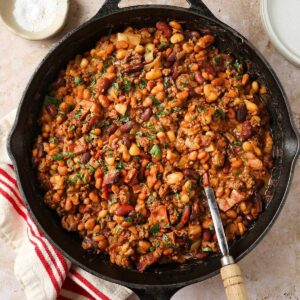Baked haddock is a light and delicious seafood dish that is both easy to prepare and bursting with flavor. Known for its mild taste and flaky texture, haddock is a favorite among seafood lovers and makes a great dinner choice. This dish’s popularity stems from its versatility and quick preparation, allowing you to enjoy a wholesome meal without spending too much time in the kitchen. Whether you’re a novice cook or an experienced chef, baked haddock is the perfect recipe to add to your repertoire.
This dish is traditionally served with lemon wedges, herbs, and a drizzle of olive oil, but you can customize it with your favorite flavors. It’s often associated with coastal cuisine, especially in regions like New England, where fresh seafood is a staple.
Ingredients
-
4 haddock fillets (about 4-6 oz each)
-
2 tablespoons olive oil
-
1 tablespoon lemon juice (freshly squeezed)
-
2 cloves garlic, minced
-
1 teaspoon paprika
-
1/2 teaspoon dried thyme (or fresh thyme)
-
Salt and pepper, to taste
-
1/4 cup breadcrumbs (optional, for a crispy topping)
-
1 tablespoon parsley, chopped (for garnish)
Substitutions:
-
For gluten-free: Use gluten-free breadcrumbs or skip the breadcrumb topping.
-
For dairy-free: This recipe is naturally dairy-free, but you can add a bit of dairy-free butter for extra flavor.
-
For a spicier kick: Add a pinch of cayenne pepper or red chili flakes to the seasoning mix.
Step-by-Step Cooking Instructions



1. Preheat the Oven
-
Preheat your oven to 400°F (200°C) to ensure it’s hot and ready for baking.
2. Prepare the Haddock
-
Pat the haddock fillets dry with paper towels to remove any excess moisture. This helps to achieve a crispier texture when baked.
3. Season the Fish
-
Place the fillets on a baking sheet lined with parchment paper. Drizzle olive oil and lemon juice over the fish, then sprinkle with garlic, paprika, thyme, salt, and pepper.
4. Add the Topping (Optional)
-
If you like a crispy topping, sprinkle breadcrumbs over the fillets. Press them gently to ensure they adhere to the fish.
5. Bake
-
Bake the haddock in the preheated oven for 12-15 minutes or until the fish flakes easily with a fork. If using breadcrumbs, they should be golden and crispy.
6. Garnish and Serve
-
Once the fish is baked, remove it from the oven and sprinkle with chopped parsley for a fresh, vibrant finish.
Pro Tip: Avoid overcooking the haddock, as it can become dry. The fish is done when it flakes easily with a fork and is opaque throughout.
Pro Tips and Cooking Techniques
-
For a Juicy Fish: Adding a tablespoon of butter or a splash of white wine over the fillets before baking can help keep the fish moist and flavorful.
-
Use Fresh Haddock: Fresh fish will always yield the best flavor and texture, but frozen haddock works just as well when thawed properly.
-
Even Cooking: Ensure your fillets are of similar thickness to allow for even cooking. If they vary in thickness, consider adjusting the cooking time or cutting thicker pieces into smaller sections.
Variations and Customizations
-
Vegetarian Version: For a plant-based option, try substituting haddock with a hearty vegetable like cauliflower steaks or use a vegan fish alternative.
-
Low-Carb Option: Skip the breadcrumbs and serve the baked fish with a side of sautéed greens or a cauliflower mash for a low-carb, keto-friendly meal.
-
Herb Variations: Experiment with different herbs like dill, basil, or rosemary to change the flavor profile of the dish.
Serving Suggestions
-
Side Dishes: Serve your baked haddock with a light salad, roasted vegetables, or a side of rice pilaf. A lemony quinoa or couscous would pair perfectly with the dish as well.
-
Sauces: A simple tartar sauce or garlic butter sauce complements the flavors of the baked fish beautifully.
-
Beverages: A crisp white wine, like Sauvignon Blanc or Pinot Grigio, would be the perfect pairing. Alternatively, a sparkling water with a slice of lemon offers a refreshing non-alcoholic option.
Nutritional Information
Here’s a general nutritional breakdown for one serving of baked haddock (without breadcrumbs):
-
Calories: 200-250 kcal
-
Protein: 30-35g
-
Carbs: 5g
-
Fat: 10-12g (mostly from olive oil)
-
Fiber: 1g
Note: Nutritional values will vary based on portion size and any modifications made to the recipe (like using breadcrumbs or adding butter).
Frequently Asked Questions (FAQs)
1. Can I use another type of fish?
Yes! While haddock is ideal, you can substitute it with other white fish like cod, pollock, or tilapia. Just adjust the cooking time based on the thickness of the fillets.
2. How do I store leftovers?
Store leftover baked haddock in an airtight container in the refrigerator for up to 2 days. Reheat gently in the oven to preserve its texture.
3. Can I freeze baked haddock?
Yes, you can freeze baked haddock. Let it cool completely, then wrap it tightly in plastic wrap and aluminum foil. It will keep in the freezer for up to 3 months. To reheat, bake it in the oven from frozen, though it may take a bit longer to cook.
Closing Thoughts
Baked haddock is a wonderfully simple yet flavorful dish that anyone can master. Whether you’re looking for a weeknight dinner or a special meal for guests, this recipe delivers in taste and ease. With the option to customize it to suit your dietary needs, it’s an incredibly versatile seafood option.
Now it’s your turn—try out this baked haddock recipe, and don’t forget to share your results or ask any questions in the comments below.



